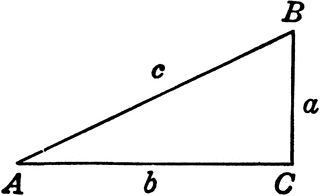Solving Right Triangles
Key Questions
-
In Triangle
ABC with the right angle atC , leta ,b , andc be the opposite, the adjacent, and the hypotenuse ofangle A . Then, we havesin A=a/c Rightarrow "m"angle A=sin^{-1}(a/c) sin B=b/c Rightarrow "m"angle B=sin^{-1}(b/c)
I hope that this was helpful.
-
The sum of the measures of all the angles in a triangle is always equal to
180^o .In a right triangle, however, one of the angles is already known: the right angle, or the
90^o angle.Let the other two angles be
x andy (which will be acute).Applying these conditions, we can say that,
x+y+90^o=180^o x+y=180^o-90^o x+y=90^o That is, the sum of the two acute angles in a right triangle is equal to
90^o .If we know one of these angles, we can easily substitute that value and find the missing one.
For example, if one of the angles in a right triangle is
25^o , the other acute angle is given by:25^o +y=90^o
y=90^o-25^o
y=65^o -
Right triangles are a special case of triangles. You always know at least one angle, the right angle, and depending on what else you know, you can solve the rest of the triangle with fairly simple formulas.

If you know any one side and one angle, or any two sides, you can use the pneumonic soh-cah-toa to remember which trig function to use to solve for others.
ul s i n( theta) = ul o pposite/ ul h ypotenuse
ul c os(theta) = ul a djacent/ul h ypotenuse
ul t an(theta) = ul o pposite/ul a djacentOpposite refers to the side which is not part of the angle, adjacent refers to the side that is part of the angle, and the hypotenuse is the side opposite the right angle, which is
C in the image above.For example,lets say you know the length of
a and the value of angleA in the above triangle. Using the cosine function you can solve forc , the hypotenuse.cos(A) = a / c Which rearranges to;
c = a/cos(A) If you know the length of both sides
a andb , you can solve for the tangent of either angleA orB .tan(A) = a/b Then you take the inverse tangent,
tan^-1 to find the value ofA . -
Inverse trigonometric functions are useful in finding angles.
Example
If
cos theta=1/sqrt{2} , then find the angletheta .By taking the inverse cosine of both sides of the equation,
=> cos^{-1}(cos theta)=cos^{-1}(1/sqrt{2}) since cosine and its inverse cancel out each other,
=> theta = cos^{-1}(1/sqrt{2})=pi/4
I hope that this was helpful.
-
Solving a right triangle means finding missing measures of sides and angles from given measures of sides and angles.
I hope that this was helpful.